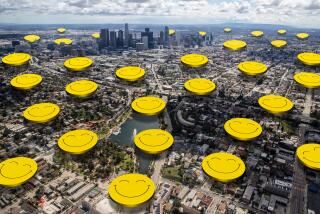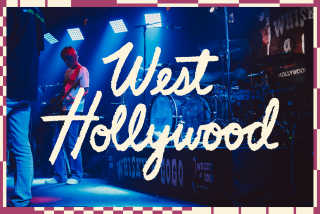Tour of City Walls Opens Window Into L.A.’s Soul
There are more than 1,500 murals in this city of pictures: They are landscapes, histories, religious icons, funny portraits, political calls-to-arms. Some of the best are half-hidden behind ugly buildings that sprang up after they were painted. Some are peeling and nearly invisible. Some are newly restored.
They pop out on the sides of ordinary structures all over town, far too many to view in an afternoon. From the wryly named “Hog Heaven,” painted on the walls and fences of the Farmer John meat-packing plant in Vernon, to the glowing image of the Madonna at Our Lady Queen of Angels Church downtown, the murals are a window into the many facets of Los Angeles.
A morning’s drive to see half a dozen or so of these public artworks will take you off the freeways (although many of the city’s murals are painted on underpasses) and into neighborhoods that reflect the city’s growth and population changes.
This could be one of many L.A. mural tours: It starts and ends downtown, fanning out into the Eastside and Exposition Park. This particular drive, developed for this story, draws heavily on Mexican-themed murals. Other tours -- of the Westside, South Los Angeles or San Fernando Valley -- would include more paintings showing the histories of other groups.
Other tours could be developed from the Los Angeles Cultural Heritage Commission’s “L.A. Walls” booklet, mural links at USC’s public art page, at www.usc.edu/isd/archives/la/pubart/LA_murals/, or tour books from the Los Angeles Mural Conservancy.
We started with two downtown murals near the original pueblo. You can park near Our Lady Queen of Angeles, 535 N. Main St., just south of Cesar Chavez Avenue.
On the side of the church is an image of the Virgin of Guadalupe, painted for the 2000 Jubilee. It has become a shrine, flanked by rows of burning candles in a nearly hidden alley between Main and Spring streets.
Slightly farther east is Placita de Dolores, which is not named in the Thomas Bros. guide, but is part of the pueblo historical area on Main Street, between Los Angeles Street and Cesar Chavez Avenue. In the plaza, which is right across the street from Union Station on Alameda Street, is the tiled mural “Father Hidalgo Rang the Bell of Dolores,” by Eduardo Carillo. Dedicated by President Carter in 1979, it’s also called “Father Hidalgo in Front of the Bell of Dolores,” and shows leading figures in the revolution for Mexican independence. From there, it is easy to get back in the car and drive east on Cesar Chavez. The tour is heading toward Goez Art Studio’s famous L.A. triptych, “La Vida Breve de Alfonso Fulano,” or “The Short Life of John Doe,” at 4716 Cesar Chavez Ave.
There are several interesting murals along the way. At Echandia Street, “Open the Curtains” by John Zender Estrada shows heroic images of Cesar Chavez and Mexican revolutionary Emiliano Zapata. Farther along, in the White Memorial Medical Plaza parking lot, is a George Yepes mural the hospital calls “Christ Healing” but is listed as “Tikkun Olam,” a Hebrew phrase meaning “to heal the world,” in several reference guides.
This once was a predominantly Jewish neighborhood, although the mural is decidedly Christian, with images of Jesus on the cross.
The Menos Fruit Market, on the north side of Cesar Chavez, sports a long, wide mural showing fruits and vegetables, and at Gage Avenue Self-Help Graphics, there’s a mural made of bright shards of broken plates.
“Read,” Josefina Quesada’s mural showing children clutching books and a fiery rainbow of knowledge pouring from a stack of books, adorns the Anthony Quinn Public Library at North Hazard Avenue.
At Dangler Avenue, on a Los Angeles County facility that faces Cesar Chavez, is “La Vida Breve de Alfonso Fulano.”
The mural depicts the history of East Los Angeles, its first panel showing an old man lying in a field of marigolds, telling the story of the land to a small boy. The middle panel shows an idealized version of East L.A. as artist Jose Luis “Joe” Gonzalez experienced it in the 1940s. The scene shows the P Line of the old Red Car system, along with men in Zoot suits and children playing marbles.
“There is a little boy trying to get a ride on a mule cart,” Gonzalez said. “That was me as a little kid.”
After viewing Gonzalez’s work, mural tourists can turn around on Cesar Chavez and head west to Soto Street. Turn left, or south, on Soto, passing several more murals before the area turns industrial.
We are heading now toward the Farmer John plant to see “Hog Heaven,” showing pigs that have apparently entered paradise after a trip through the slaughterhouse. It is on the east side of Soto between 37th Street and Vernon Avenue.
Park across the street and walk a bit to see this huge depiction of idealized farm scenes, which stretches a full city block.
From there, head west on Vernon to the Harbor Freeway. Exit at Exposition Boulevard. From the service road, which is Hope Street, you can see a huge mural on your right (east side of the street) at the Mercado La Paloma. Turn left on Exposition. Turn left again on Vermont. At 3965 Vermont Ave., on the north-facing wall, is “Exposition Park Welcomes the World,” also built by Gonzalez and the Goez studio. Partly obscured by a commercial building, the mural is best seen from Leighton Avenue.
Finally, no tour of Los Angeles murals would be complete without a look at the images on two sides of the historic Victor Clothing Building downtown. This last destination will provide several choices for lunch.
Continue south on Vermont to Martin Luther King Jr. Boulevard, and turn left, or east, onto Figueroa Street.
Turn left again on Figueroa and head back downtown. A right turn on 2nd Street will take you through a tunnel to Broadway, where you can turn right and park. Victor Clothing will be on the left.
The murals are on two sides of the building. On the north side is “Bride and Groom,” by Kent Twitchell, and next to it is a colorful portrayal of the 1984 Olympics. On the building’s south side, best viewed from 3rd Street, is an evocative portrait of Anthony Quinn, revered by many as a groundbreaking Latino actor, dancing in front of the building’s main foyer.
Next to Quinn, and in need of repair, is a fourth mural, “Nino y Caballo,” by Frank Romero, of a boy riding a horse beneath the Victor Clothing logo.
Just south on Broadway is the renovated Grand Central Market, a fun place for lunch or food shopping. Those seeking fancier digs can hike up the many steps from Hill Street, at the back of the marketplace, to California Plaza, which has several restaurants.
If you have a question, gripe or story idea about driving in Southern California write to Behind the Wheel c/o Los Angeles Times, 202 W. 1st St., Los Angeles, CA 90012, or send an e-mail to behindthewheel@latimes.com.
More to Read
Sign up for The Wild
We’ll help you find the best places to hike, bike and run, as well as the perfect silent spots for meditation and yoga.
You may occasionally receive promotional content from the Los Angeles Times.






